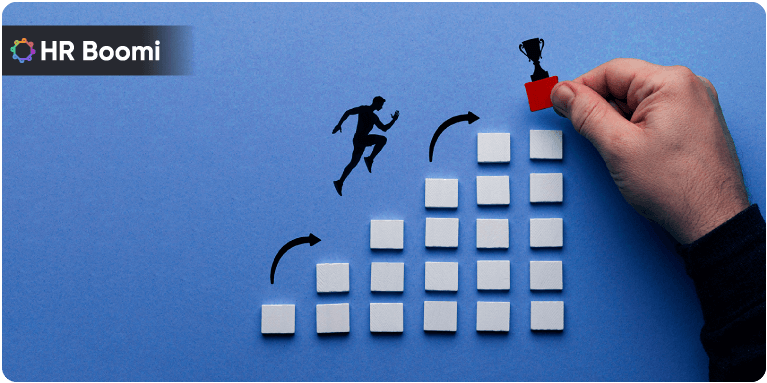
Table of Contents
- Significance of Automated Performance Management Systems For Employee Performance Challenges
- Essentials for Implementing Performance Automation
- Policy Focused on Performance
- Setting Clear KPIs and KRAs
- Spot and Nurture Areas of Improvement
- Comprehensive Reviews for Enhanced Quality
- Ongoing Assessment for Course Correction
- Final Thoughts
The personnel management team in a business often grapples with the daunting task of ensuring that employee output aligns with expected deliverables and timelines. This is vital for building and maintaining long-term, fruitful client relationships for the organization’s success. In a diverse workforce, it’s particularly challenging for these managers to harness the full potential of each individual. On top of this, tasks such as payroll administration, leave management, and regulatory compliance add layers of complexity, heightening the risk of oversights.
Given these employee performance challenges, it’s clear that digital HR tools, especially those equipped with performance management features, are no longer a luxury but a necessity. These systems centralize and streamline employee-related tasks, aligning individual goals with the broader organizational roadmap. A robust performance management tool can pinpoint areas needing attention, empowering the organization to refine their team’s abilities to meet quality and volume demands.
Source: Explaining the Performance Management Revolution
Significance of Automated Performance Management Systems For Employee Performance Challenges
HR professionals juggle many tasks daily, necessitating a structured approach to prioritize them effectively. Among these, payroll management frequently stands out as a critical function, showcasing the growing need for automation in daily performance tracking. Automated systems not only streamline this process but also reinforce consistency and accuracy.
Moreover, for businesses operating under stringent standards, conducting daily assessments of completed tasks is vital. Such regular checks ensure that projects remain on schedule and align with the company’s goals. Doing so helps guarantee that the organization consistently meets its targets and maintains its reputation for reliability.
Essentials for Implementing Performance Automation
In today’s fast-paced business landscape, leveraging technology is no longer just an option—it’s a necessity. For businesses aiming to extract the full value from a Performance Management System (PMS), the foundation lies in integrating technology seamlessly into their operations. However, the success of such systems isn’t solely reliant on technology but also hinges on the harmonious interaction between staff and management.
For any PMS to be truly effective, transparent communication from the leadership is paramount. When a company clearly articulates its short-term tasks and long-term visions, it offers a roadmap for employees to follow. This transparency ensures everyone is moving in the same direction and offers moments of reflection and celebration as milestones are reached. Such achievements act as catalysts, driving motivation and amplifying the collective pursuit of excellence and productivity.
Policy Focused on Performance
Historically, manual performance assessments have been susceptible to human biases or inadvertent errors, sometimes leading to skewed perceptions of an employee’s capabilities. However, the advent of automated systems has heralded a new era where these potential pitfalls can be mitigated. Organizations can introduce structured policies that ensure fair and consistent evaluations by leveraging technology.
Moreover, such automated systems recognize the diverse roles within an organization and can be tailored accordingly. For employees anchored to office desks, the emphasis might be on the tangible outputs within set hours, reflecting their direct contributions. Conversely, for those in field roles where direct client engagement is frequent, the quality and quantity of these interactions become paramount. This nuanced approach ensures that each employee is evaluated based on metrics relevant to their specific role, ensuring a more equitable assessment process.
Setting Clear KPIs and KRAs
Setting clear and measurable metrics is fundamental for an organization to align its workforce with the overarching goals and to deliver on promises made to stakeholders. Two prominent tools in this endeavor are KPIs and KRAs. While KPIs offer a granular view by quantifying specific outputs—like units produced or services delivered—KRAs provide a more macro perspective, mapping the journey towards significant organizational objectives, such as market expansion or product diversification.
Incorporating these defined metrics into the reward and compensation structure holds added significance. Employees are given both a roadmap and motivation by tying tangible rewards to performance indicators. This linkage drives individual excellence and fosters a culture of continuous improvement, propelling the entire organization toward achieving its strategic vision.
Source: Role of KRA/KPI in Appraisal System
Spot and Nurture Areas of Improvement
Within any organization, the array of talents and skills is as varied as the distinct roles and functions of each finger on a hand. While a strength, this diversity also necessitates regular monitoring to ensure that every team member is optimally contributing. With consistent oversight, potential gaps or underutilized talents might be noticed, affecting overall productivity and alignment with organizational goals.
By utilizing detailed departmental reports, organizations can identify individuals who may be struggling or underperforming. Instead of sidelining these employees, proactive engagement is key. Providing them with specific feedback, mentorship, and tailored training programs can hone their skills and realign their efforts with the company’s objectives. Such interventions not only empower individuals to excel in their roles but also enhance the team’s collective performance, driving the organization toward its broader vision.
Comprehensive Reviews for Enhanced Quality
Gathering feedback from diverse stakeholders offers a comprehensive view of a company’s operations and areas of potential growth. As employees navigate their tasks, it becomes essential for the company to have a structured review mechanism—be it through ratings, star systems, or other benchmarks. Such a mechanism identifies standout performers and pinpoints areas that might need enhancement.
Furthermore, feedback isn’t just about internal reviews. When insights from clients, managerial staff, colleagues, and HR teams are combined, they provide a rich tapestry of information. This helps in finetuning operational processes and assures the delivery of high-quality products or services. By embracing this all-encompassing feedback model, companies can cultivate an environment that champions excellence, encourages self-betterment, and spurs healthy competition among team members.
Ongoing Assessment for Course Correction
Traditional manual annual reviews, while valuable, can sometimes miss nuances in performance trends and employee growth areas, especially if these issues emerge between review periods. Such oversights accumulate over time, leading to unforeseen challenges or inefficiencies within the organization. This method might also delay necessary interventions, potentially harming the organization’s overall output and quality.
On the other hand, automated performance tracking systems offer a more dynamic approach. They provide real-time insights into employee performance, ensuring that deviations or anomalies are detected immediately. By promptly identifying and rectifying these issues, companies can ensure consistent quality in their deliverables. This proactive approach minimizes operational hiccups and plays a crucial role in maintaining and strengthening valuable client relationships.
Final Thoughts
The modern business landscape demands a shift towards innovative HR management tools, with performance management systems standing out as game-changers. These tools propel companies towards accelerated growth and ensure a noticeable ROI uplift due to optimized employee productivity. As the world leans towards digital solutions, businesses must adopt technology-driven strategies. Such strategies guarantee precision and mitigate the inconsistencies and errors inherent in traditional human-led processes. Companies must seamlessly blend technology with human resources to thrive in today’s competitive market, ensuring efficiency and excellence.
Recent Posts
-

In-house vs. Outsourced Payroll: Pros and Cons
-

Mastering Talent Retention: A Corporate Challenge
-

What is employer branding and how to apply it in your company?
-

The Significance of Employee Communication Within
-

What is time management and why is it important?
-

Net salary: what is it and how is it calculated?
-

Enhancing Employee Experience: Strategies for Excellence
-

10 Best Gifts to Boost Sales Channels
